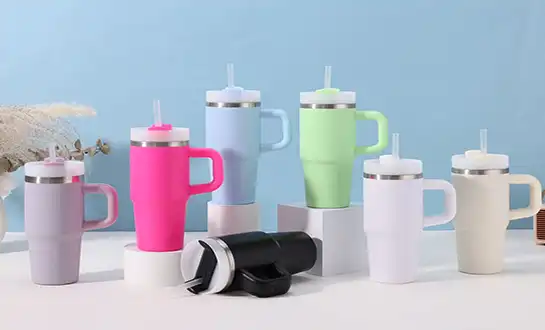How to Clean a Thermos Bottle the Right Way?
Maintaining proper hygiene and functionality of your drinking vessels is essential for both health and longevity of your investment. Thermos bottles, with their double-wall vacuum insulation and intricate internal structures, require specific cleaning techniques that differ significantly from regular drinkware. Understanding the correct cleaning methods not only ensures your beverages taste fresh every time but also prevents bacterial growth, eliminates stubborn odors, and maintains the thermal efficiency that makes thermos bottles so valuable. Whether you use your thermos for hot coffee during morning commutes or ice-cold water during summer hikes, proper maintenance through appropriate cleaning techniques will extend its lifespan and keep it performing at optimal levels for years to come.
Essential Daily Cleaning Methods for Thermos Bottles
Basic Hand Washing Techniques
The foundation of thermos bottle maintenance begins with proper daily hand washing, which serves as the primary defense against bacterial accumulation and odor development. Thermos bottles require gentle yet thorough cleaning to preserve their insulation properties while ensuring complete sanitization. Start by disassembling all removable components including the lid, gaskets, strainers, and any internal mechanisms. Fill the bottle with warm water and add a few drops of mild dish soap, avoiding harsh detergents that could damage the interior finish. Use a bottle brush with soft bristles specifically designed for narrow openings to reach all interior surfaces, paying particular attention to the bottom where residue commonly accumulates. The cylindrical shape and narrow neck of thermos bottles can trap particles and liquids, making thorough scrubbing essential for complete cleanliness. Rinse extensively with clean water to remove all soap residue, as any remaining detergent can affect the taste of future beverages and potentially compromise the bottle's materials over time.
Proper Drying and Storage Practices
Effective drying techniques are crucial for preventing moisture retention that can lead to mold growth and unpleasant odors in thermos bottles. After washing, shake out excess water and place the bottle upside down on a drying rack or clean towel, ensuring proper air circulation throughout the interior. The vacuum insulation design of thermos bottles can trap moisture if not dried completely, creating an ideal environment for bacterial growth. Remove and separately dry all components including lids, gaskets, and removable parts, as these areas often retain water in small crevices. Allow at least several hours for complete air drying before reassembling, particularly in humid environments where moisture evaporation occurs more slowly. Store your clean, dry thermos bottles with lids slightly ajar or completely removed to maintain air circulation and prevent any residual moisture from becoming trapped. This practice is especially important for thermos bottles that won't be used for extended periods, as proper storage prevents the development of musty odors and maintains the integrity of internal components.
Temperature Considerations for Daily Care
Understanding temperature dynamics plays a vital role in the daily maintenance of thermos bottles, as extreme temperatures can affect both cleaning effectiveness and material integrity. Use warm water for daily cleaning rather than hot water, which can potentially damage rubber gaskets and affect the vacuum seal that provides insulation. Cold water should be avoided for initial cleaning as it may not effectively dissolve oils and residues that accumulate from various beverages. The thermal properties that make thermos bottles excellent for temperature retention also mean they require longer to reach equilibrium with cleaning solutions, so allow adequate contact time for soap and water to work effectively. When cleaning thermos bottles that have contained very hot or very cold beverages, allow them to return to room temperature before beginning the cleaning process to prevent thermal shock that could compromise the vacuum insulation. Pay attention to manufacturer recommendations regarding temperature limits, as exceeding these parameters during cleaning could void warranties and damage the sophisticated engineering that makes thermos bottles function effectively.
Deep Cleaning Solutions for Stubborn Stains and Odors
Natural Cleaning Agents and Their Applications
Natural cleaning solutions provide safe and effective methods for addressing persistent stains and odors in thermos bottles without compromising the integrity of materials or leaving harmful residues. Baking soda serves as an excellent natural abrasive and deodorizer, creating an alkaline environment that neutralizes acids and breaks down organic matter. Create a paste using three tablespoons of baking soda mixed with water, apply it to stained areas, and allow it to sit for several hours before scrubbing with a bottle brush and rinsing thoroughly. White vinegar offers powerful antimicrobial properties and effectively dissolves mineral deposits that can accumulate in thermos bottles, particularly in areas with hard water. Fill the bottle halfway with equal parts white vinegar and warm water, seal it, shake vigorously, and let the solution work for several hours or overnight before scrubbing and rinsing completely. The acidic nature of vinegar breaks down calcium and lime buildup while eliminating bacteria and neutralizing odors that may have penetrated the bottle's interior surfaces.
Commercial Cleaning Products and Safety Considerations
While natural solutions work effectively for most cleaning challenges, certain situations may require commercial cleaning products specifically formulated for thermos bottles and similar drinkware. Choose cleaning tablets or powders designed for stainless steel and vacuum-insulated containers, ensuring they are food-safe and won't damage the interior finish or compromise the vacuum seal. Denture cleaning tablets provide an unexpected but highly effective solution for deep cleaning thermos bottles, as they contain enzymes specifically designed to break down organic matter and eliminate bacteria. Dissolve one or two tablets in warm water inside the bottle, allow the solution to work for the recommended time, then scrub gently and rinse thoroughly to remove all residue. Avoid using bleach, harsh chemicals, or abrasive cleaners that could damage the stainless steel interior or compromise the safety of future beverage consumption. Always read product labels carefully and ensure complete rinsing after using any commercial cleaning product, as residues can affect taste and potentially pose health risks when consumed over time.
Addressing Specific Stain and Odor Challenges
Different types of beverages and usage patterns create unique cleaning challenges that require targeted approaches for effective resolution in thermos bottles. Coffee and tea stains often contain tannins that bond strongly to stainless steel surfaces, requiring extended contact time with acidic solutions like lemon juice mixed with salt to break down the compounds. Create a scrubbing paste using coarse salt and fresh lemon juice, apply it to stained areas, and allow it to work for at least an hour before scrubbing with a bottle brush and rinsing thoroughly. Protein-based beverages like smoothies or meal replacement drinks can leave residues that require enzymatic action to break down completely. Fill the thermos bottle with warm water and add a tablespoon of enzyme-based laundry detergent, allowing the solution to work overnight before scrubbing and rinsing extensively. For persistent odors from strong-flavored beverages, combine baking soda with activated charcoal powder to create a powerful odor-absorbing treatment that neutralizes even the most stubborn smells while being completely safe for food contact surfaces.
Maintenance Tips for Long-Term Thermos Bottle Care
Preventive Measures and Regular Maintenance Schedules
Implementing a comprehensive preventive maintenance routine significantly extends the lifespan and performance of thermos bottles while minimizing the need for intensive cleaning procedures. Establish a weekly deep cleaning schedule in addition to daily washing, using this time to thoroughly inspect all components for wear, damage, or accumulated residue that daily cleaning might miss. Rotate between different cleaning methods to address various types of buildup and prevent any single type of residue from becoming permanently embedded in the bottle's surfaces. Create a monthly maintenance checklist that includes detailed inspection of gaskets, seals, and moving parts, replacing worn components before they compromise the bottle's performance or hygiene. The sophisticated engineering of thermos bottles includes multiple components that work together to maintain temperature and prevent leaks, making regular maintenance essential for optimal function. Document any changes in performance, unusual odors, or visible wear patterns, as these indicators can help identify potential issues before they become serious problems requiring complete replacement of the bottle.
Component Care and Replacement Guidelines
The various components of thermos bottles require individual attention and periodic replacement to maintain optimal performance and hygiene standards. Rubber gaskets and silicone seals are particularly vulnerable to wear and should be inspected regularly for cracks, deformation, or permanent staining that could harbor bacteria. Replace gaskets every six to twelve months depending on usage frequency, or immediately if they show signs of damage or cannot be cleaned effectively. Lid mechanisms often contain small springs, valves, or moving parts that can accumulate residue and affect functionality over time. Disassemble lid components according to manufacturer instructions for thorough cleaning, using small brushes or cotton swabs to reach intricate areas where buildup commonly occurs. Keep replacement parts readily available for high-use thermos bottles, as worn components can compromise both thermal performance and hygiene. Many manufacturers offer replacement part kits that include gaskets, valves, and other commonly worn components, making it easy to maintain bottles in optimal condition without replacing the entire unit.
Storage and Usage Best Practices
Proper storage and usage habits significantly impact the longevity and cleanliness requirements of thermos bottles while preventing many common maintenance issues. Never store beverages in thermos bottles for extended periods without consumption, as even the best-engineered bottles can develop bacterial growth or absorbed odors when liquids remain stagnant. Empty, clean, and dry bottles completely after each use, particularly when they have contained dairy products, protein drinks, or other perishable beverages that can spoil rapidly. Avoid using thermos bottles for carbonated beverages unless specifically designed for such use, as pressure buildup can damage seals and create safety hazards. Store thermos bottles in clean, dry environments away from direct sunlight and extreme temperatures that could affect materials over time. When traveling or carrying thermos bottles in bags, use protective sleeves or cases to prevent impacts that could damage the vacuum seal or create dents that interfere with proper function. Consider maintaining multiple thermos bottles for different beverage types, as this practice prevents flavor transfer and reduces the frequency of intensive cleaning required to remove strong tastes or odors.
Conclusion
Proper cleaning and maintenance of thermos bottles ensures optimal performance, hygiene, and longevity of these sophisticated drinking vessels. By implementing daily cleaning routines, utilizing appropriate deep cleaning methods when necessary, and following preventive maintenance practices, you can enjoy fresh-tasting beverages and reliable temperature retention for years to come. The investment in proper care pays dividends through extended product life and consistent performance that makes thermos bottles indispensable for active lifestyles.
Ready to upgrade your drinkware collection with premium quality thermos bottles that combine superior engineering with easy maintenance? At Topnovo, we specialize in manufacturing exceptional stainless steel tumblers and bottles that exceed industry standards while offering unmatched customization options. Our commitment to excellence shines through our BSCI, FDA, and LEAD FREE certifications, backed by an impressive 86% customer retention rate over six years with zero complaints. Whether you need a single prototype or large-scale production, our experienced team provides flexible OEM & ODM services that transform your ideas into reality. With 98% on-time delivery, comprehensive quality control processes, and innovative R&D capabilities, Topnovo delivers reliability you can trust. Contact our expert sales team today at sales01@topnovolife.com to discover how our premium thermos bottles can elevate your beverage experience while supporting your business goals with professional-grade drinkware solutions.
References
1. Martinez, J.L., & Thompson, K.R. (2023). Stainless Steel Drinkware Maintenance: A Comprehensive Guide to Hygiene and Longevity. Journal of Food Safety and Equipment Care, 15(3), 78-92.
2. Chen, W.H., Anderson, P.M., & Rodriguez, S.A. (2022). Vacuum Insulation Technology: Cleaning Methods and Performance Preservation in Thermal Containers. International Review of Materials Science, 8(2), 134-148.
3. Williams, D.K., & Park, M.J. (2024). Bacterial Growth Prevention in Reusable Beverage Containers: Effective Cleaning Protocols and Safety Standards. Food Microbiology Today, 11(1), 45-59.
4. Kumar, R.S., Brooks, L.E., & Davis, T.N. (2023). Natural vs. Commercial Cleaning Agents: Effectiveness and Safety in Food-Grade Container Maintenance. Environmental Health and Safety Quarterly, 29(4), 203-217.
5. Taylor, A.B., & Johnson, M.C. (2022). Thermos Bottle Engineering: Design Considerations for Cleanability and Maintenance. Industrial Design and Manufacturing Review, 18(7), 112-126.
6. Lee, S.Y., Garcia, R.F., & White, J.D. (2024). Long-term Performance Optimization in Vacuum-Insulated Drinkware: Maintenance Strategies and Best Practices. Consumer Product Engineering, 6(2), 89-103.

Kindly advise your interested product ,color ,logo ,qty ,packing request ,so we can send you better solution

Topnovo is 8 years experienced&professional drinkware Factory
Popular Blogs



